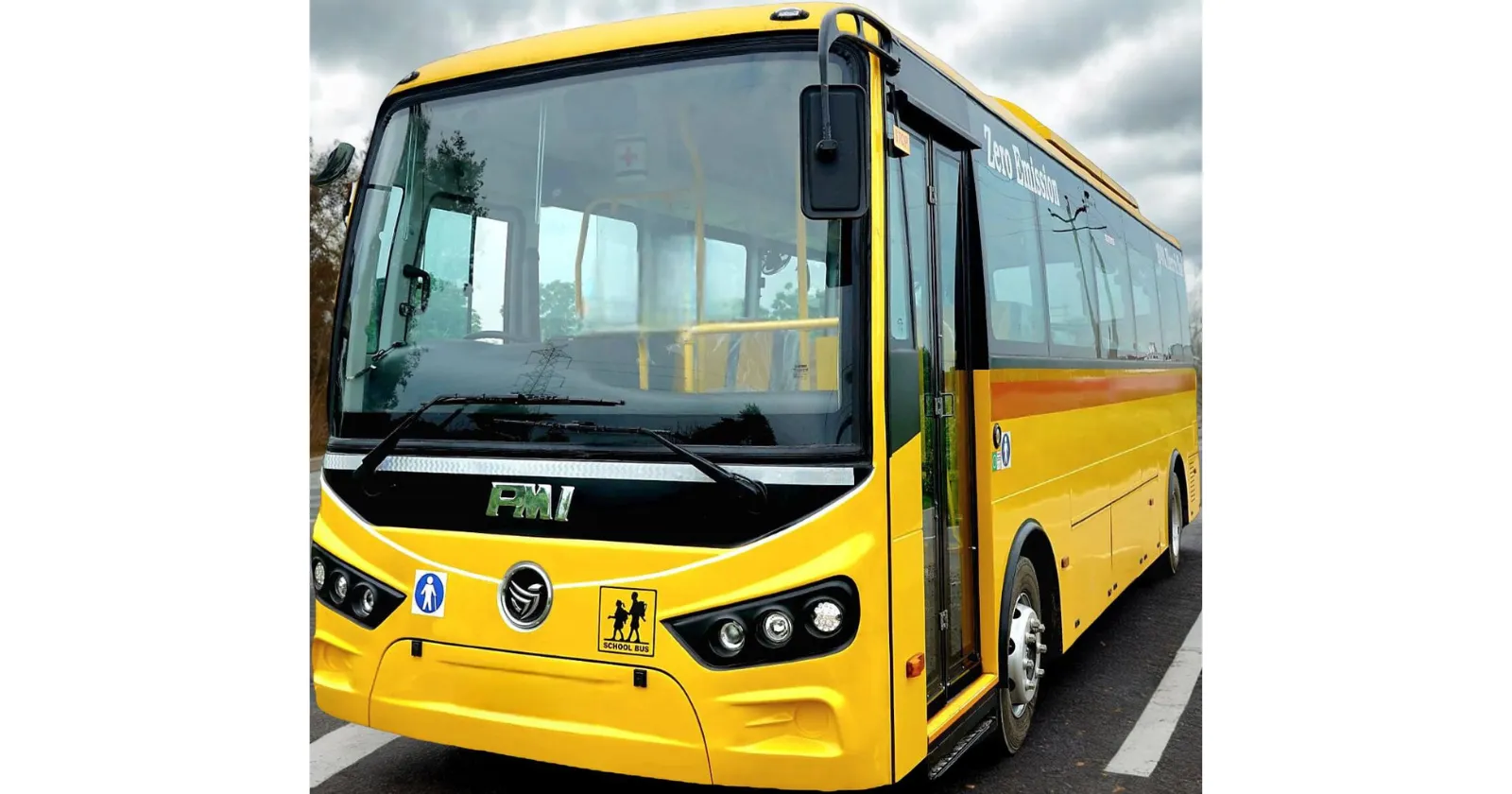
PMI Electro Mobility expects the school bus segment to be a key driver for the Indian electric bus market. Plans segment entry next month.

Share Post

PMI Electro Mobility expects the school bus segment to be a key driver for the Indian electric bus market. Plans segment entry next month.
The people mover segment of buses is also a key driver of the electric mobility trend in the country. And in that segment a relatively lesser known player, PMI Electro Mobility, has managed to lead the pack of over a dozen e-bus makers in the country in terms of registrations, for the first nine months of 2025.
According to VAHAN, India’s national vehicle registry system, 754 e-buses made by the Delhi based start-up have been registered between January 1 and October 12. Olectra Greentech comes a very close second with 750 registrations, followed by 711 for Switch Mobility e-buses.
So, what has helped the 8 year old e-bus maker to achieve a market leading performance, apart from the products it manufactures? “Focus”, says Dr. Aanchal Jain, CEO, PMI Electro Mobility, and a second generation entrepreneur, who also admits that there have been phases of FOMO (Fear Of Missing Out) in the journey. “Sometimes we might get a pushback, saying we must do this or that also. But we were very focussed on what we were doing,” she says.

PMI Electro Mobility has till date sold around 2,900 e-buses, of which 734 units saw registrations during 2024. It plans to sell 1,400-1,500 e-buses this year. The e-bus industry is set to surpass last year’s registrations during this year. A little over 3,500 e-buses have seen registrations during this calendar year so far. Last year, the figure stood at 3618 units, a 37% growth over the previous year’s registration volume.
PMI Electro Mobility, which has its roots in the coach making business in the Group, has an annual installed production capacity of 3,000 e-buses at its facility in Dharuhera, Haryana.
Of the three major bus segments of intracity, inter-city, and school buses, the intracity segment, led by State Transport Undertakings, has the lion’s share in terms of leading the EV charge. Of the current parc of around twelve lakh buses, intracity buses are estimated to be at around two lakh units.
In terms of EV adoption, Dr. Jain says the intracity segment has already reached the inflection point. “And that is where I see future demand in the intracity bus segment. I expect it to be mostly electric,” she says.
Going by the EV adoption trend in intracity bus segment, particularly by STUs, PMI Electro Mobility is bullish that the cumulative number of 50,000 e-buses under the PM e-Drive and PM eBus Sewa schemes can be achieved within the next two years.
“Initially, we received orders for electric buses from places that did not have buses, mainly due to the FAME incentives. They were like, we might as well do it. Now we've reached a stage where STUs who had their traditional diesel buses are now moving to electric fleets. They see it is cheaper,” says Dr. Jain.
Arguing for the case of electric buses, she explains that with a driving cycle of 180-200 kilometres a day, 365 days a year, the TCO (Total Cost of Ownership) “worked out very well” as the operator can potentially achieve a breakeven point by year three or four for a 12-year contract.
It is estimated that the per kilometre fuel cost of a diesel bus is around ₹30, compared to approximately ₹8 in an electric bus. And this could be the major contributor in savings of around ₹ 1.5 crore over a twelve year usage period, far offsetting the premium of around ₹ 40 lakh in the acquisition cost of an electric intracity bus, according to Dr. Jain.
The school bus segment, with a very different set of usage dynamics, is the next segment PMI Electro Mobility wants to enter, and be one of the early movers in this space. It has bagged an order for 30 electric school buses, deliveries of which will begin next month.
School buses run around a hundred kilometres daily, for around 250 days a year. Unlike intercity buses, its replacement also happens earlier at about 8 years. These factors make it more challenging for EVs to be competitive in the school bus segment. “And that's the thing we actually worked on a lot, where we've reduced the delta between the diesel bus and school bus so much that we will make it an attractive product,” says Dr. Jain, while declining to reveal the “proprietary” approaches taken to reduce price delta.
The acquisition cost of PMI Electro Mobility’s school bus is approximately 20-30% higher than a comparable ICE version, and the “substantial” operational cost savings is being pitched as a key factor to pitch for the EV. “With fuel cost savings alone ranging between ₹25–₹30 per kilometre, customers can achieve overall opex savings of ₹60–₹70 lakhs over a 7-year period,” according to Dr. Jain. The school bus market in India is pegged at 20,000 to 30,000 units a year in India.
According to the e-bus maker, the domestic electric bus market is poised for exponential growth over the next 3–5 years, and the school bus sub-segment holds immense potential.
The introduction of competitively priced electric school buses, and the added benefits of zero tailpipe emissions, are expected to power a rapid shift toward electrification. “Furthermore, state government subsidies—often around ₹10 lakh per bus—are making the electric alternative even more attractive for fleet operators. Overall, we project electric bus sales to grow 3 to 4 times within the next three years, with the school bus segment emerging as a key driver of this momentum,” says Dr. Jain.
As the EV journey progresses, PMI Electro Mobility plans to expand its presence beyond the bus segment. It plans to enter the electric LCV (Light Commercial Vehicle) segment, and has started trials of its eLCV. These eLCVs will be positioned in the B2G (Business-to-Government) segment, which its maker sees as a “strategic extension” of its capabilities as last mile delivery and Government logistics adopt the EV route for tailpipe emission-free transportation. .
Tapping the bourses is also in the cards for PMI ELectro Mobility, which so far has raised ₹750 crore in multiple rounds of fund raising. An IPO is something that the EV maker is “working on”, and may be floated in a year and half from now if the market conditions are favourable.
It’s been a satisfying journey so far in the EV space for Dr. Jain, who perhaps would have had a different career journey, as an Economist-academician in the USA. The COVID pandemic, which kept her away from the larger family for over three years, triggered her move back to India.
And now, PMI Electro Mobility, started by her father in 2016 at the age of 60, aims to be a “global-standard electric mobility brand, delivering innovative, inclusive transport solutions” proudly wearing the ‘Made in India’ badge. The immediate goal is to double last year’s revenue, which stood at ₹800 crore.
Mercedes-Benz Design Head Wagener Quits After 28 Years, Bastian Baudy To Succeed
Acko Drive Team 18 Dec, 2025, 4:03 AM IST
India at Dakar 2026: Sanjay Takale Announces Participation with Aerpace Racers
Acko Drive Team 17 Dec, 2025, 12:56 PM IST
ACMA, Spark Minda Host Tech Show to Strengthen Tier-2 and Tier-3 Supplier Capabilities
Acko Drive Team 17 Dec, 2025, 11:36 AM IST
Tesla Must Change Autopilot Marketing or Lose California Sales for 30 Days
Acko Drive Team 17 Dec, 2025, 10:11 AM IST
First Tesla Superchargers in Gurugram Now Operational
Acko Drive Team 17 Dec, 2025, 9:43 AM IST
Looking for a new car?
We promise the best car deals and earliest delivery!
